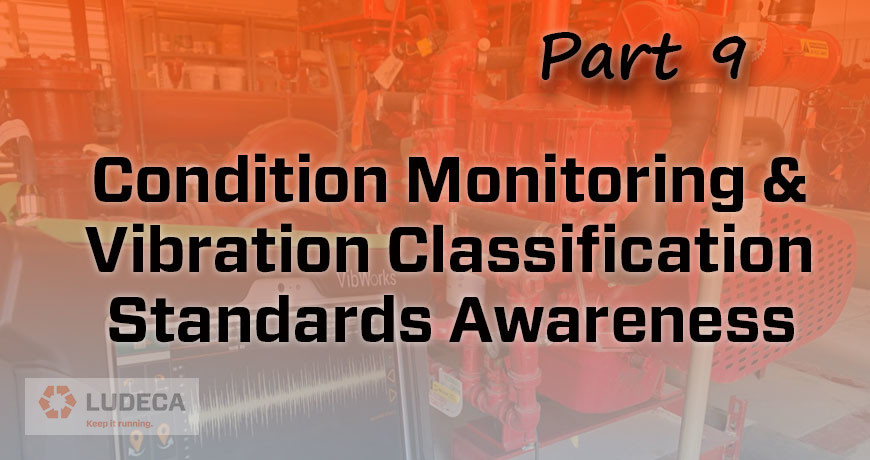
Disclaimer: The author is not trying to present himself as an authority on all available CM standards. This blog post is simply an attempt to help those who may be unaware that such guidance exists or of the extent of such standards.
We previously discussed a series of international standards pertaining to condition monitoring of industrial equipment with vibration analysis in, Condition Monitoring & Vibration Classification Standards Awareness: Part 8 20816-9:2020This blog is number 9 in a series of blogs describing some international standards as a help to our Ludeca partners. This blog is about the xx816 standard that concerns itself with industrial wind turbines. The standard described in this blog regards collecting and classifying the vibration of horizontal axis wind turbines with a mechanical gearbox and a rated output exceeding 200kw. See the scope quoted below for the complete description of covered machines. The ISO 10816-21 standard is formatted with the evaluation zones of A to D, just like the other 10816 & 20816 standards, but only offers guidance for the zone boundaries for onshore machines (found in Annex A).
Both acceleration and velocity band quantities are assessed by this standard with many more averages than most of the greater population of industrial equipment; averages overtime of 10 minutes being typical to classify the vibration of the nacelle and tower. Less is needed for the gearbox and generator. The lowest band required by this standard begins at 6cpm (0.1hZ) for the tower, nacelle, and gearbox, while the band with the highest cutoff (5kHz or 300kcpm) is required on the generator.
This standard does provide some acceptance testing guidance. As with most of the other standards in the general xx816 family, “-21” gives guidance for some general condition assessment, but does not attempt to provide diagnostic guidance.
This standard is titled:
ISO 10816-21:2015
Mechanical vibration — Evaluation of machine vibration by measurements on non-rotating parts
Part 21: Horizontal axis wind turbines with gearbox
The scope of this standard is quoted below from the ISO.org preview page (quotation in bold):
Scope:
This part of ISO 10816 specifies the measurement and evaluation of mechanical vibration of wind turbines and their components by taking measurements on non-rotating parts. It applies to horizontal axis wind turbines with mechanical gearbox and rated generator output exceeding 200 kW and the following design and operational characteristics:
- installation on supporting systems (tower and foundation) made of steel and/or concrete;
- horizontal axis rotor with several rotor blades;
- rotor bearing separate from or integrated into the gearbox;
- generators are driven via gearbox;
- generators of the synchronous or asynchronous type (mostly equipped with 4-pole generator);
- generators with only a fixed pole number or which are pole-changeable for speed adjustment;
- output control by rotor blades (pitch or stall wind turbines);
- generator coupled to the power grid via converter or directly.
This part of ISO 10816 recommends zones for evaluating the vibration at continuous load operation. However, in most cases, these evaluation zone boundaries might not be suitable for the early detection of faults. This part of ISO 10816 does not specify vibration values for the zone boundaries because there are insufficient data available for the complete range of wind turbines in the worldwide fleet covered by this part of ISO 10816. However, for information only, Annex A presents evaluation zone boundaries for onshore wind turbines. These zone boundaries are based on vibration data from about 1 000 wind turbines with rated generator output up to 3 MW. They can be helpful in facilitating discussion between users and manufacturers. Evaluation zone boundaries for offshore wind turbines are not yet available.
Although the type and implementation of broad-band vibration monitoring for wind turbines is addressed, this part of ISO 10816 does not apply to diagnostics or fault detection by condition monitoring of wind turbines.
NOTE 1 Information on condition monitoring and diagnostics of wind turbines will be given in ISO 16079 (all parts)1.
The evaluation of the balance quality of the slowly turning wind turbine rotor, which requires special measurements and analysis, is not covered by this part of ISO 10816.
This part of ISO 10816 does not apply to the evaluation of torsional vibration in the drive train. Although coupled lateral and torsional vibration of the tower and drive train can affect the amplitudes of the defined vibration characteristics, diagnosis of this kind of vibration source is not feasible by the described measurement methods described in this part of ISO 10816. For general design verification purposes and for specific fault diagnosis, special measurements are required which are beyond the scope of this part of ISO 10816.
NOTE 2 IEC/TS 61400–13 describes load measurement by use of strain gauges on the supporting structure and blades. Techniques to assist the detection of rolling element bearing and gearbox defects can be found in ISO 13373-2. Measurement and evaluation of structure-borne noise with rolling element bearings are given in VDI 3832.
This part of ISO 10816 does not also apply to acceptance measurements on gearboxes and generators in the manufacturer’s test facility.
NOTE 3 These are assessed on the basis of appropriate standards namely ISO 8579-2 and IEC 60034–14.
To read the ISO’s preview of this standard, click here.
This concludes our series of planned standards blog posts. Requests for further informational blogs on standards will be considered. Thank you for your attention.
Filed under:
Condition Monitoring by Mike Fitch CRL
